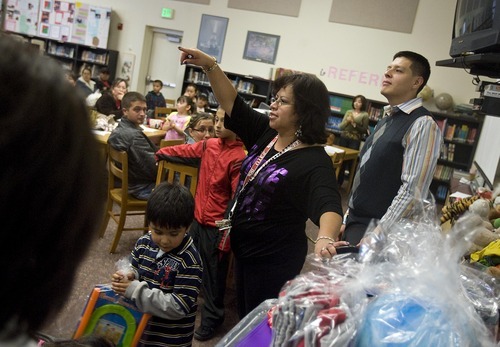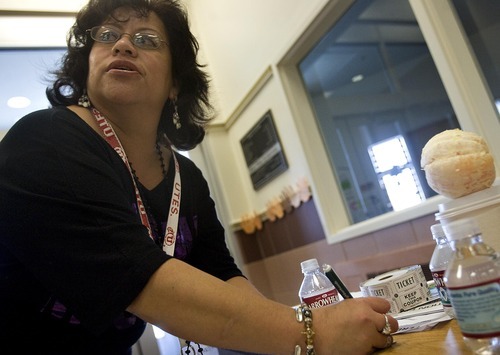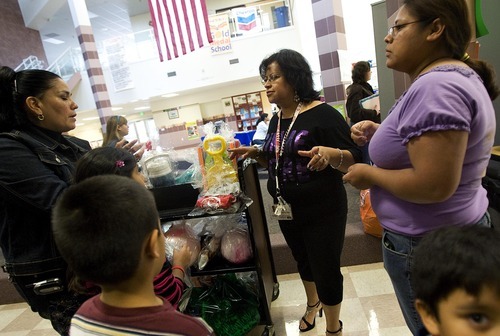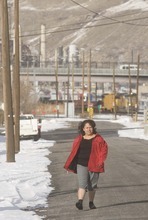This is an archived article that was published on sltrib.com in 2011, and information in the article may be outdated. It is provided only for personal research purposes and may not be reprinted.
For the sake of their children's health, Maria and Jorge Barajas needed to move. The run-down duplex they were renting on the west side of Salt Lake City was dangerous.
A visiting nurse, checking on their premature daughter, pointed out peeling paint on the walls and window frames and suspected lead. She smelled mold and feared the spores would trigger an asthma attack, since the baby already struggled to breathe.
"You have to get out of this apartment," Maria recalls the nurse telling her.
The family bought a house down the street, attracted by its big kitchen and even larger backyard for their three children, with another to come.
But while they live in one of the healthiest states in the nation, the family remains in what Utah Department of Health data show is a ghetto of poor health. Residents on the west side of Salt Lake City are among the least likely to have access to medical care, to fit in exercise or to shun smoking. They have some of the worst health — from having diabetes to dying early.
Today, The Salt Lake Tribune launches an occasional series about geographic health disparities — why those living in west-side areas are ailing and the ways residents are trying to take charge of their health, from studying nutrition to growing gardens to adding streetlights.
Access to care and good genes are important to health. But more critical are social factors such as education, income and race, according to the Robert Wood Johnson Foundation, whose mission is to improve the health and health care of all Americans.
Research also increasingly points to how your neighborhood can profoundly influence health: It determines what food you eat and recreation spots you have, your exposure to pollution and crime, and whether your community works together to fight graffiti or fix up parks.
"To say the sole determinant of my behavior is my intention — that's really not the case," says James Vanderslice, an expert in geography and health, and a professor at the University of Utah's Department of Public Health.
In short, he says, we don't start at the same point on the path to good health. Income, education and environment can put you on a fast track or they can set up roadblocks.
"The choices are not the same between people," says Jennifer Seelig, a Democratic state lawmaker who represents the west side neighborhood of Rose Park and has pushed public health measures at the state Capitol. "We're not all born into the same set of circumstances."
—
Unhealthy living •Surrounded by three interstate freeways, an airport, a freight rail line and heavy industrial businesses, the city's west-side residents are among the state's poorest, least educated and most ethnically diverse, according to health department data. (See the low-income map at http://bit.ly/fuszbV, the education map at http://bit.ly/hWRQNZ, and the Latino map at http://bit.ly/h4ndu0).
They also live in the worst of the worst when it comes to hazardous waste sites.
Salt Lake County has the second-heaviest toxic pollution burden in the nation, according to the U.S. Environmental Protection Agency. And residents of Rose Park and Glendale live amid the largest concentration of hazardous waste sites in the county, according to an analysis by TheTribune . (See the toxic sites map at http://bit.ly/dKerOw and the per capita map at http://bit.ly/hPXbJh). A quarter of the county's hazardous waste spots — facilities that release, handle or clean up toxic waste — are in those neighborhoods.
After Mormons settled the valley in 1847, the area was largely ignored due to its poor soil and Jordan River floods. Forty years later, railroad tracks spanned 400 West and spawned factories and warehouses. Mexicans, Greeks, Italians, Russians and Japanese came to work, and they lured developers to build housing. Later, freeways were built in the middle of neighborhoods, isolating the area, now home to the city's industrial zone.
The legacy is poor health.
West-side residents say they're the sickest (See the health status map at http://bit.ly/eRg0RH) — and they're among the least able to get care because they lack health insurance. West-side children with asthma are more likely than children almost anywhere else in Utah to end up in the hospital. The rates for teen births and sexually transmitted diseases outpace the nation. About as many adults smoke as those in tobacco-producing states.
They lead different lives than their richer, more educated Salt Lake City neighbors in the foothills and Avenues: Glendale adults are some of the least likely to eat fruits and vegetables or to schedule physical activity, while those in neighborhoods around the University of Utah eat the healthiest and prioritize exercise.
While about one-third of adults in Rose Park and Glendale are obese, they live near the state's trimmest, in the Avenues.
And with Utah's lowest life expectancy, Glendale residents die 9½ years earlier than some of state's longest-living residents in the foothills; Rose Park lives are cut short by four years. (See the life expectancy map at http://bit.ly/gMVzyy)
—
Income + education = better health •Gary Edwards, executive director of the Salt Lake Valley Health Department, attributes the concentration of poor health on the area's concentration of poverty — Glendale's average home price of $120,000 is the least expensive in five Wasatch Front counties — which is linked to low education levels.
Higher education not only helps people understand health information, which leads to healthier choices, according to research,but it leads to better-paying jobs with health insurance, money to pay for nutritious food and to live in safer neighborhoods with better schools and access to recreation.
"If we had, in every ZIP code in Salt Lake County, affordable housing, we would not have pockets" of poor health, Edwards said.
Maria Barajas, a high school graduate, understands the importance of education: She took a leadership course sponsored by the University of Utah with the goal of improving her neighborhood. Worried about how heavy children are getting, she helped organize a nutrition fair. With a high concentration of Latinos in the neighborhood, and the culture's emphasis on breads and beans, her neighbors need encouragement to incorporate fruits and vegetables into their diets, she said.
"Most of us don't make enough money to afford those foods that are better for you," she said, pointing to how fresh poultry is more expensive than fried chicken.
Along with money, time is a factor.
"They [west-side parents] are working all the time. When the kids come home from school, there's nothing prepared for them," she said. "They just eat prepared foods that they can just pop in the microwave."
Instead of placing unpeeled fruit on the table, which was ignored by her children, Maria now entices them with cut-up papayas and melons.
—
The price of the 'Phantom' •National research by Utahns shows that living in a poor area is bad for your health, even if you aren't poor.
"It can be as risky as smoking to your risk of mortality," says Norman Waitzman, an economics professor at the U.
He and U. family and consumer-studies professor Ken Smith have published studies showing Americans who had the same income, education and race but lived in different neighborhoods died at different rates:
Those living in disadvantaged neighborhoods where most residents are poor, uneducated and living in substandard housing were twice as likely to die during middle age than those living in better neighborhoods. And the risk was not due to violence or crime.
They called that 1998 study "Phantom of the Area" because it wasn't clear why neighborhoods are more deadly than others. Research by others has shown how chronic stress and the release of cortisol and adrenalin wear down the body, contributing to a weakened immune system, cardiovascular disease and obesity.
Waitzman, Smith and others now are examining the link between obesity and geography, finding that struggling neighborhoods are a risk factor for Utah teens.
Waitzman, who hasn't specifically analyzed the west side, isn't surprised its residents have poor health. He ticks off a list of contributors, including unemployment, crime, exposures to train noise and environmental risks such as refineries and freeways.
"These are communities under stress," he says. "It's not a matter of whether someone is going to go out and exercise. It's a matter of [all of the] effects of living in a disadvantaged environment."
—
'Insult to injury' •On a walk around her neighborhood at 600 West and 300 North, Maria Barajas points out its hazards: To the north, plumes of chemicals spew from oil refineries. A block east, Union Pacific trains carrying hazardous chemicals, including ammonia, sulfuric acid and chlorine, are so close they shake her house and wake her up at 1 a.m. Big rigs use her residential street as an extended entrance and exit to two nearby freeway ramps. To the west, she has a view: The "mountains" etched onto the gray sound wall of Interstate 15.
No doubt the Barajases and their neighbors live amid dangerous chemicals. With the Tesoro refinery just over a mile away and the Chevron refinery about three miles away, they are exposed to at least 53 toxic chemicals, which area companies told the EPA they released into the air, land and water in and near Rose Park and Glendale in 2008.
The chemicals can't be seen as the cause of a specific illnesses. But each of the chemicals is known to harm at least one critical organ, including the brain, heart and lungs, or function, such as digestion, reproduction and hormone balance. At least 21 of the chemicals are classified as carcinogens.
Salt Lake County has the second-heaviest toxic pollution burden in the nation, according to reports by the polluting companies themselves to the EPA's Toxics Release Inventory (TRI). And, with the exception of Kennecott Utah Copper neighbors like Copperton and Magna, Rose Park and Glendale are surrounded by more toxic pollutants than any other Salt Lake County neighborhoods, based on 2008 TRI statistics.
In Rose Park, the toxic burden was nearly two pounds per person, with 11 sites releasing nearly 70 tons per year. In Glendale, it was more than 19, with 18 sites releasing nearly 290 tons. Compare that to Holladay, where the per capita emissions in 2008 were zero.
"It's adding insult to injury," said Brian Moench, founder of the Utah Physicians for a Healthy Environment. "There are so many factors that clearly paint a picture that people who are socioeconomically disadvantaged from the standpoint of health."
The EPA agrees that west-side residents are disproportionately exposed. It recently granted state agencies a $100,000 grant to work with Salt Lake City neighborhoods west of State Street on children's environmental health. A preliminary analysis pointed to problems, which include lead exposure and asthma.
—
Unsafe at home • A neighborhood's vibe can also influence health.
Barajas, 40, says she won't go for a walk after 5 p.m.: Homeless men hop on and off trains and wander down her street. She called police when a drunken man seemed to set up camp under a tree next to her house.
When she walks during the day, she adds, diesel exhaust from the trains makes her head ache.
Barajas approaches the duplex her family left behind: A run-down red-brick structure with peeling paint. She remembers the sounds of scurrying rats and cockroaches. But the rent was $450.
Derelict homes, with their water leaks, poor ventilation, dirty carpets and pests, can boost mold and mites — which can create or exacerbate asthma. Three of her four children have asthma. Maria recently learned she has lupus, an autoimmune disease, in which the body's immune system becomes hyperactive and attacks normal, healthy tissue.
"We have the smog that comes out from the cars, the trains and just down that way the refineries," Barajas says in Spanish over the dull roar of the freeway. "We don't pay too much attention. But if you think about it, with my daughters having asthma and the problems I am having, it probably does have an effect."
Moving again is not an option. With her handyman husband out of work, Maria worries about being able to pay the mortgage and fears ending up in an unlivable apartment again. Plus, she likes where she lives. She walks to church, her children's schools and downtown. And the size of west side lots are hard to beat: There's room for a trampoline and volleyball net out back.
As for the worse parts of the neighborhood, she says, "We just got used to it."
Tribune reporter Judy Fahys and Tribune Computer Assisted Reporting Editor Tony Semerad contributed to this report.
This story was reported with the assistance of interpreter Maritza McKee. —
About the project
This article was conceived and produced as a project for The California Endowment Health Journalism Fellowships, a program of the University of Southern California's Annenberg School for Communication & Journalism.
Want to know how your neighborhood ranks?
Go to extras.sltrib.com/healthy_for_whom to view maps showing the state's income, education and race data broken down by small area, along with health data, including smoking rates, health status, life expectancy and death rates. —
The series
Healthy for whom? • Utah is considered one of the healthiest states in the nation — but not everyone benefits. There are wide disparities in health based on residents' education, ethnicity and environment. —
Income, education and diversity
Residents on the west side are among the state's poorest, least educated and most diverse, according to health department data.
Income • In 2008, half the adults in Glendale lived in a household where the annual incomes were less than $25,000 a year.
Education • About one-quarter of residents in Glendale and Rose Park didn't have a high school diploma.
Diversity • 2009 public school data show 86 percent of children qualify for free or reduced-price lunch, meaning they live at or near poverty levels. And 2009 school enrollment shows 81% of the students are of color. —
About the research • Analyzing the health of neighborhoods
The Utah Department of Health has divided the state into 61 small areas, with populations ranging from 16,000 to 60,000, based on ZIP codes, political boundaries and similar demographics. It's done to understand a community's health status, lifestyle and environment.
As drawn by the health department, Rose Park and Glendale communities mostly sit west of Interstate 15, with Rose Park north of 400 South and Glendale between 400 South and 2100 South.
The Salt Lake Tribune analyzed dozens of health measures — access to health care, lifestyle risk factors and outcomes — broken down by the small areas. The data were age-adjusted, meaning that an area's concentration of elderly or youth wouldn't skew the data.













